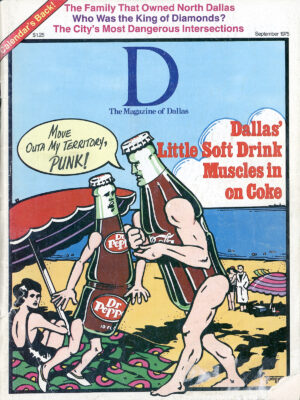No subject today strains the fabric of our city more than public schools. Neighborhood schools reflect us, the neighbors who support them. Healthy neighborhoods, filled with people who know each other and trust each other, engender healthy schools. When a neighborhood changes to a community filled with nervousness, mistrust and misunderstanding, its school and its children suffer.
Free-lance writer Doug Holley tells us about searching to decide whether his five-year-old daughter should attend Henry W. Longfellow Elementary School, once one of the finest schools in the Dallas Independent School District. Today Longfellow School has lost much of the neighborhood support that once made it a wonderful school.
Twenty-two years ago this month I picked up my metal lunch kit and trotted down the back steps, off for my first day at Longfellow. I cut across Mrs. Morton’s backyard, a dear lady who baked me a cake on each birthday, and whose husband fixed my bicycle after my frequent collisions with trees. Up the alley past the other $10,000 G.I. homes – I knew the occupants of every one.
An old policeman, whose name I have long since forgotten, helped us across busy Inwood Road, which separated the neighborhood from the school. Each December my mother would dispatch us to hand him a Christmas card with a dollar inside.
My second grade teacher was Miss Tressie Johnston, a dedicated woman who was burdened with 50 pupils, but nevertheless gave us the individual attention we needed. She split us into small reading groups. I was in the fastest one and we read to each other while Miss Johnston helped the slowest readers, some of whom could barely read their own names.
Longfellow’s faculty cared. My third grade teacher, Mrs. Hill, once stopped me to ask about an abnormal skin condition on my hand which my parents hadn’t even noticed. Another day she noticed me squinting at the blackboard and had the nurse test my eyes, which proved to be near-sighted. And one day when someone stole my prized possession, a fringed buckskin jacket, school principal Carl Nutley rounded up the culprit within an hour.
Today the neighborhood, Holley tells us, is nervous and has lost much faith in Longfellow School. But he also tells us of dedicated teachers and involved parents and suggests that in its ability to call upon those two great resources Longfellow School hasn’t changed so much after all.
At the heart of the old Longfellow neighborhood was Inwood Shopping Village, where my mother bought our food at A&P, our clothes at Penney’s and occasionally took us for a lemonade at the Country Club Pharmacy. On Saturday morning she’d put 35 cents in our pockets and send us off to the kid show at the Inwood Theater. The dime would buy popcorn and the quarter would buy admission to some horror show which would scare us out of our skins.
The genius behind the Inwood Village was a young man named Will Caruth, Jr., who developed the center against his father’s advice. Caruth had built a few homes in our neighborhood, and he knew that young families needed a grocery store, a clothing store and some inexpensive entertainment. Caruth was gutsy and he was right, as Inwood survives today, thirty years later.
Since Inwood, Caruth has overseen the development of Dallas’ most fabulous landed estate. From NorthPark to Medallion Center, across to SMU and University Park, Caruth has left his mark, with barely a trace of publicity. Editor Jim Atkinson unfurls the Caruth story as Will Caruth, Jr., looks back over his life’s work of guiding the development of a billion dollars worth of family land and looks to the future of one of Dallas’ most storied families.
One of Caruth’s first land sales was to the Dr Pepper Company, which built its national headquarters, with the familiar 10-2-4 clock, at Mockingbird and Greenville. Dr Pepper had been a sleepy regional company until W. W. “Foots” Clements assumed the presidency in 1970.
Dudley Lynch tells us about the Dr Pepper-gulping Clements who is cha-rismatically leading his company on a siege of the soft drink world. Clements has talked independent Coca-Cola bottlers all across America into helping him, a thrust which has left some Coke executives steamier than a hot Dr Pepper.
It’s all part of Clements’ plan to out-politic, outfox and outrun his giant competitors. Lynch tells about the ins and outs of the politics in your neighborhood supermarket, and how Dr Pepper intends to get ahead there. Next time you’re in the supermarket, take note of how much space Dr Pepper occupies on the soft drink counter. By the time you return, Dr Pepper may have grabbed more.
Get our weekly recap
Brings new meaning to the phrase Sunday Funday. No spam, ever.
Related Articles

Local News
In a Friday Shakeup, 97.1 The Freak Changes Formats and Fires Radio Legend Mike Rhyner
Two reports indicate the demise of The Freak and it's free-flow talk format, and one of its most legendary voices confirmed he had been fired Friday.

Local News
Habitat For Humanity’s New CEO Is a Big Reason Why the Bond Included Housing Dollars
Ashley Brundage is leaving her longtime post at United Way to try and build more houses in more places. Let's hear how she's thinking about her new job.
By Matt Goodman

Sports News
Greg Bibb Pulls Back the Curtain on Dallas Wings Relocation From Arlington to Dallas
The Wings are set to receive $19 million in incentives over the next 15 years; additionally, Bibb expects the team to earn at least $1.5 million in additional ticket revenue per season thanks to the relocation.
By Ben Swanger


